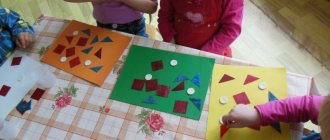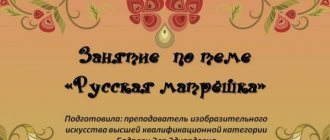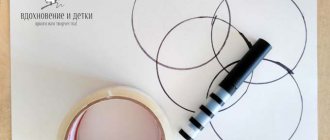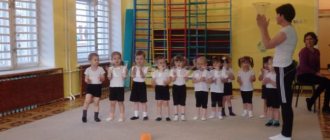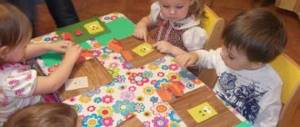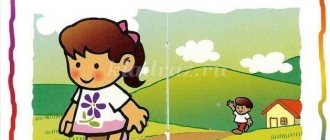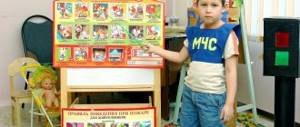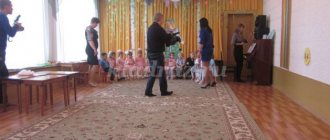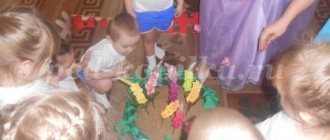Thematic lesson: Matryoshka dolls
The month ends and with it time for the competition task of Maria Kostyuchenko’s project “Toys of the Peoples of the World - Matryoshka”. Finally, we had a lesson on nesting dolls. It took me a long time to prepare for it, primarily because we simply don’t have nesting dolls. And the first thing I had to do was glue the nesting dolls out of paper . It turned out great - just real nesting dolls. But the work is labor-intensive. I got the finished patterns and detailed instructions here.
We started getting acquainted with the nesting dolls with the poem :
- Oh, you matryoshka young lady, I’ll take you in my hands, Show me those girls who are sitting inside you! Oh, you little matryoshka doll, Multi-colored clothes, The whole wide world knows this Russian souvenir!
She took out the nesting dolls and told the story: How much? (Ya. Taits)
Dad brought Masha a nesting doll and said: “Here are three toys for you.” - Why three? – asked Masha. - One nesting doll. “Let’s count,” said dad. - One? - One!
Dad opened the nesting doll, there was another, smaller one. - Two? - Two!
Dad opened the second one, and there was another, the smallest one. - Three? “Three,” Masha laughed. “That’s it,” said dad. Here they are all standing!
True, we have five nesting dolls, and I changed the story a little. By increasing the number of nesting dolls to five.
Games with nesting dolls: Then I suggested that Dima assemble them himself - by picking up the upper and lower parts of the nesting dolls. They lined them up in order. From the part of the prefabricated pyramid, I suggested choosing cups for the nesting dolls and giving them tea.
We folded the frames and inserts of the Matryoshka dolls . Dima is already doing this very well and quickly, because he has been training for a week already. After all, I made them already then. She suggested numbering them - laying out plates with numbers from the largest nesting doll to the smallest. I did it easily.
Then they put the nesting dolls in order . First from 1 to 10. Then from 11 to 20. The first one folds easily. And the second – let’s look at the table of the second ten. But he really likes this task!
Using the pages of the album , we learned how and what matryoshka dolls are made from .
We learned the history of the creation of the matryoshka doll . We read poems about this in the album. Dima really liked that everything on these pages opens up. He didn’t even let me finish reading the poems that were written inside the nesting dolls, how interested he was in opening and closing them.
Seeing that Dimka was starting to get bored, she decided to hold a Fizminutka :
We are funny nesting dolls, okay, okay. Our clothes are nice, okay, okay. We spin and dance, okay, okay. We will lead a round dance, okay, okay.
And we watched the Children's dance - Russian nesting dolls . Surprisingly, Dima liked it so much that he tried to imitate them. And when the video ended, I asked to play it again!
We watched the cartoon “The Secret of the Matryoshka” . When I found it and watched it for the first time, it didn’t make the same impression on Dima as it did this time. This is what it means to be in the mood and prepare your child for viewing!
Dima could not calm down and demanded to see something else. And I also played him this video . It’s good to watch before doing creative work, which is what we later did.
But first, I suggested playing with colors using cards of 100 colors and matryoshka stencil . I made the stencil so that you need to put two cards and the scarf will be one color, and the dress will be another. I named what colors should be, and Dima laid them out. He liked the game.
Our creativity was mixed with getting to know different types of nesting dolls . We read poems about each type of nesting doll in the album, and I briefly talked about the features of this type. Then she showed in the album how to decorate a dress and a scarf. And Dima has already done a large separate drawing himself. So we drew the Zagorsk nesting doll with our fingers and cotton swabs.
Semenovskaya matryoshka is an applique.
And Polkhov-Maidanskaya - drawing with plasticine.
We also completed various tasks . It contains both those invented by me and those proposed by Maria Kostyuchenko. What he liked most was opening the accordion of nesting dolls and counting them - on the “Count the nesting dolls” page.
We've outlined the office, but we'll leave the coloring by numbers - it's still too early for us - for growth.
Various versions of the tasks “find identical nesting dolls” worked only the second time. For some reason, Dima didn’t immediately understand what I wanted from him. Or maybe he was tired. But after about five minutes he jumped and did everything perfectly.
At the end we read the Matryoshka book, which was not made by me. Thanks to Maria (Marso) for the book and the link to the dance.
This is how our Matryoshka day went!
Separately, I want to talk about the creation of the album.
You might be interested in:
Thematic lesson: The sixth day of creation
Thematic lesson: Adam's first task
Thematic lesson: Butterfly
Peculiarities
The main quality that distinguishes Matryoshka exercises is that classes are conducted in a playful way. Mom or teacher organizes a theatrical performance. This presentation of information makes it easier to assimilate, the baby gets less tired and remembers the exercises better. An adult reads funny poems to children, and they repeat the movements after him. This way, children get used to concentrating on the educational material, which will help them in the future when studying at school.
Matryoshka gymnastics is also a way to introduce a child to Russian culture. The main character of the game is a Russian wooden toy. To conduct classes, props are used - costumes, doll figurines, handkerchiefs and other items.
There are many rhymes and ditties for Matryoshka gymnastics. While doing the counting exercise, children will also have to answer the teacher’s questions. Having a conversation with a facilitator will help improve your speaking and numeracy skills.
